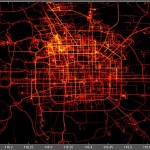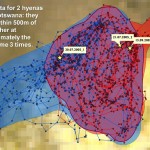A new paper that continues my research on analyzing dynamic interactions using GPS data has just been published. This article employs a null model approach to assess how six currently used dynamic interaction metrics vary in terms of the type and magnitude of interaction they measure. ‘Towards a better understanding of dynamic interaction metrics for wildlife: a null model approach‘ (also see ‘Using spatially explicit simulated data to analyze animal interactions: a case study with brown hyenas in northern Botswana‘). This work will be presented as part of a special Frontiers in GIScience Research session at the ESRI User Conference July 22, 2015.
This research is supported by NSF #1424920.


